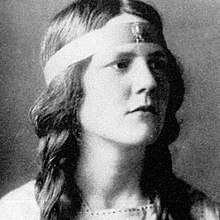Nan Shepherd
| Nan (Anna) Shepherd Hon. PhD | |
|---|---|
 Nan Shepherd | |
| Born |
February 11, 1893 Peterculter, Aberdeenshire |
| Died |
February 23, 1981 (aged 88) Woodend Hospital, Aberdeen |
| Occupation | Author, poet |
| Language | Scottish English |
| Residence | Cults, Aberdeen |
| Nationality | Scottish |
| Citizenship | UK |
| Education | Aberdeen High School for Girls |
| Alma mater | University of Aberdeen |
| Period | 20th Century |
| Genre | Novels, poetry, non-fiction |
| Literary movement | Modernism |
| Notable works |
|
Nan (Anna) Shepherd (11 February 1893 – 23 February 1981) was a Scottish Modernist writer and poet. She was an early writer in Scots, who wrote three stand-alone novels set in small, fictional communities in North Scotland. The Scottish landscape and weather played a major role in her novels and provided the focus for her poetry. Shepherd also wrote a non-fiction book on hill walking, based on her experiences in the Cairngorms. Shepherd was a lecturer of English at the Aberdeen College of Education for most of her working life.
Life
Anna Shepherd was born on 11 February 1893 in Peterculter, now a suburb of Aberdeen, to John and Jane Shepherd. Her family moved shortly after Nan was born, to the house in to Cults where she lived for most of her life. She attended Aberdeen High School for Girls and graduated from the University of Aberdeen in 1915, subsequently lecturing for the Aberdeen College of Education.[1]
Shepherd retired from teaching in 1956, but edited the Aberdeen University Review until 1963. The university awarded her an honorary doctorate in 1964.[2]
She was a friend and supporter of other Scottish writers including Neil M. Gunn, Marion Angus and Jessie Kesson.
She died in Woodend Hospital in Aberdeen in 1981.
Works
Novels
Shepherd was a major contributor to early Scottish Modernist literature. She published her first novel, The Quarry Wood, in 1928. The novel is often compared to Sunset Song by Lewis Grassic Gibbon, which was published four years later, because they both portray the restricted and often tragic lives of women in contemporary Scotland.[3] Her second novel, The Weatherhouse, was published in 1930. It deals with the interactions between people in a small Scottish community.[4] Her final novel, A Pass in the Grampians, was published in 1933.[1]
Shepherd's novels deal with the clash between the demands of tradition and the pull of modernity. The landscape and weather play a major role in all three novels, which are set in small communities in the north of Scotland.[1]
Poetry
Shepherd was a keen hill-walker and her poetry expresses her love for the mountainous Grampian landscape. While a student at university, Shepherd wrote poems for the student magazine but it wasn't until 1934 that an anthology of her poetry, In the Cairngorms, was published.[2] This volume was reissued in April 2014 by Galileo Publishers in Cambridge, with a new introduction by Robert Macfarlane.[5]
Non-fiction
Shepherd wrote a short non-fiction book, The Living Mountain, during the 1940s. The Living Mountain is a reflection her experiences walking in the Cairngorm Mountains. Having completed it, Shepherd chose not to publish the book until 1977.[6]
Recognition


Nan Shepherd is commemorated in Makars' Court, outside The Writers' Museum, Lawnmarket, Edinburgh. Selections for Makars' Court are made by The Writers' Museum; The Saltire Society; The Scottish Poetry Library.
The most well-known image of Shepherd is a distinctive portrait photograph of her as a young woman wearing a headband and a brooch on her forehead. Shepherd had decided to have her portrait taken at a local photography studio; whilst sitting for the portrait, she reportedly picked up a length of photographic film and wrapped it around her head on a whim, and attached a brooch, making herself look like a Wagnerian princess. In 2016 this photo was adapted for an illustration which was used on the new series of £5 notes issued by the Royal Bank of Scotland.[7][8][9]
In 2017 a commemorative plaque was placed outside her former home on North Deeside Road, Peterculter.
References
- 1 2 3 Ali Smith, "Shepherd, Anna (1893–1981)", Oxford Dictionary of National Biography, Oxford University Press, 2004, accessed 22 December 2013
- 1 2 "Nan Shepherd (1893 - 1981)". Scottish Poetry Library. Retrieved 22 December 2013.
- ↑ "Nan Shepherd 1893 - 1981" (PDF). Scottish Literary Tour Trust. 2003. Retrieved 22 December 2013.
- ↑ "Book Description". Canongate. September 1996. Retrieved 22 December 2013.
- ↑ "Archived copy". Archived from the original on 14 July 2014. Retrieved 10 July 2014.
- ↑ Robert Macfarlane (30 August 2008). "I walk therefore I am". The Guardian. Retrieved 22 December 2013.
- ↑ "The Tony McManus Geopoetics Lecture: Nan Shepherd: An Early Geopoet by James McCarthy, Heriot Watt University 18 November 2017 – Scottish Centre for Geopoetics". www.geopoetics.org.uk. Retrieved 10 April 2018.
- ↑ Kelly, David (26 October 2017). "Book review: Into The Mountain: A Life Of Nan Shepherd, by Charlotte Peacock". The Scotsman. Retrieved 10 April 2018.
- ↑ "Novelist and poet Nan Shepherd to appear on RBS £5 note". BBC News. 25 April 2016. Retrieved 25 April 2016.